#minoan art
Text
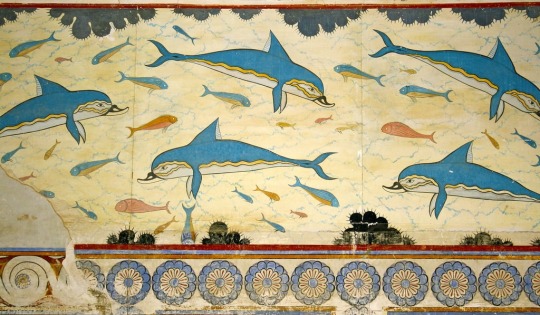

Dolphins Fresco, Palace of Knossos (& detail)
c. 1700-1450 B.C.
#knossos#fresco#dolphins#ancient art#antiquities#minoan civilization#minoan art#minoan#beautiful animals#nature#wildlife#beautiful dolphin#aesthetic#beauty#animals in art#art history#aesthetictumblr#ancient history#ancient world#tumblraesthetic#tumblrpic#tumblrpictures#tumblr art#tumblrstyle#artists on tumblr
2K notes
·
View notes
Text



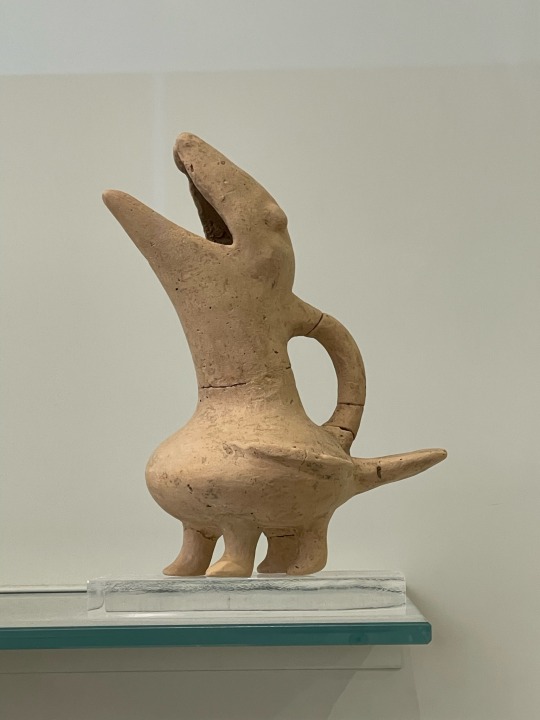
I had the immense privilege of going to Greece earlier this summer. I took 400 pictures of ancient pottery and came home inspired to put octopodes on everything.
1. My octopodes on some tiny vases and a cup
2. My reference photo of a Mycenean amphora with an octopus in the Minoan Marine Style, 1500s BCE. (National Arcaelogical Museum, Athens)
3. My bird jug with printed reference photo
4. Bird-shaped vessel from Crete, 2700 - 1900 BCE (Heraklion Archaelogical Museum, Heraklion)
2K notes
·
View notes
Text

Gold earrings, Minoan, 1850-1500 BC
from The British Museum
1K notes
·
View notes
Text

Bonding with the half-brother 🐮🧶✨
Or, Ariadne and Asterion (the Minotaur) spend some quality time together because f*ck Theseus 💅😌✨
#greek mythology#ariadne#minotaur#asterion#crete#minoa#minoan art#Ariadne's outfit is inspired by ancient minoa#since the myth of the minotaur and the labyrinth is related to knossos palace#i thought that would be nice#ancient greece#ancient minoa#theseus#ancient greek mythology#ancient history#mythology#mythology and folklore#cretan mythology#king minos#pasiphae#phaistos
604 notes
·
View notes
Text
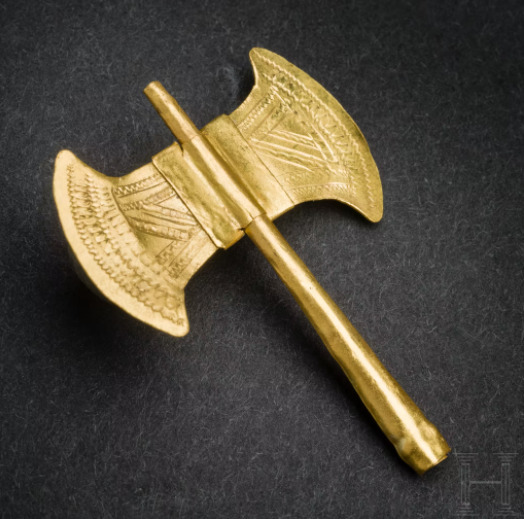
Gold sheet votive axe, Minoan, 16th-15th century BC
from Hermann Historica
817 notes
·
View notes
Text
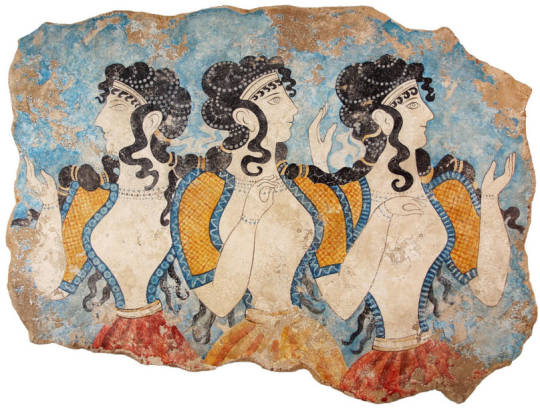
From ancient city of Knossos, Minoan Civilization on Crete, circa 2000 B.C.E.
312 notes
·
View notes
Text
For #CephalopodWeek, seen today at Brooklyn Museum:

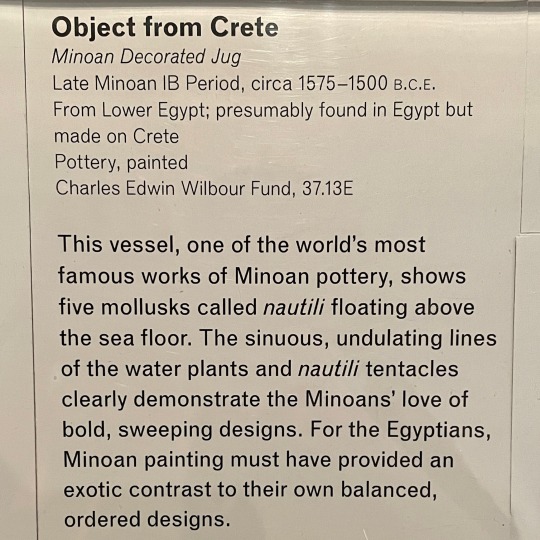
Object from Crete - Minoan Decorated Jug
Late Minoan IB Period, c. 1575-1500 BCE
From Lower Egypt; presumably found in Egypt but made on Crete
Pottery, painted
“This vessel, one of the world's most famous works of Minoan pottery, shows five mollusks called nautili [argonauts] floating above the sea floor. The sinuous, undulating lines of the water plants and nautili tentacles clearly demonstrate the Minoans' love of bold, sweeping designs. For the Egyptians, Minoan painting must have provided an exotic contrast to their own balanced, ordered designs.”
#minoan art#Crete#ancient Egypt#ancient art#nautilus#argonaut#cephalopod#Cephalopod Week#animal holiday#pottery#ceramics#museum visit#Brooklyn Museum#animals in art
372 notes
·
View notes
Text
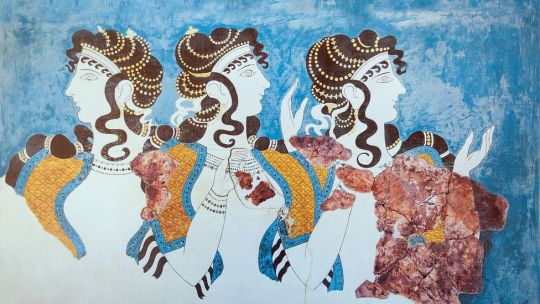
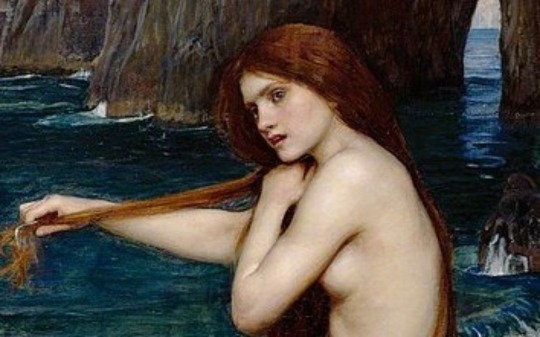
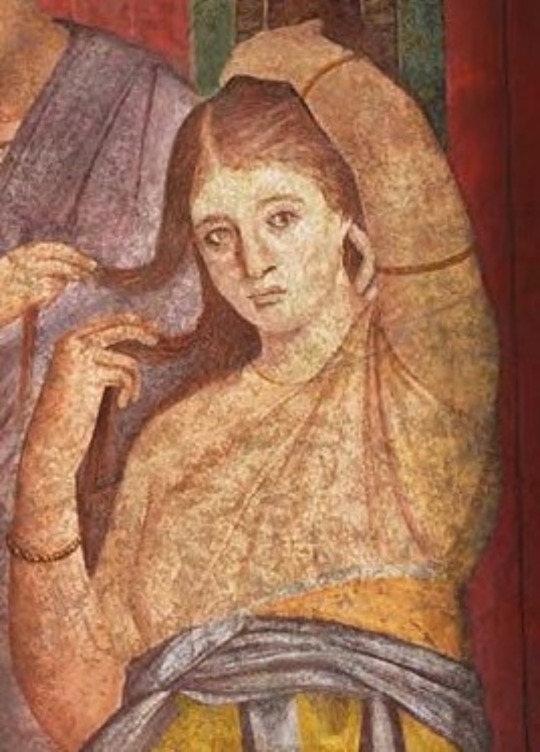


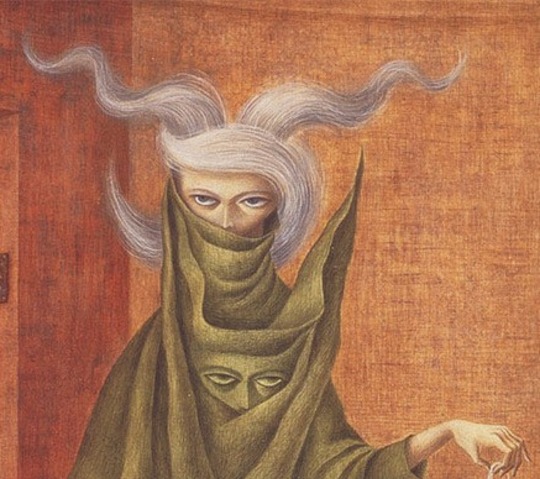

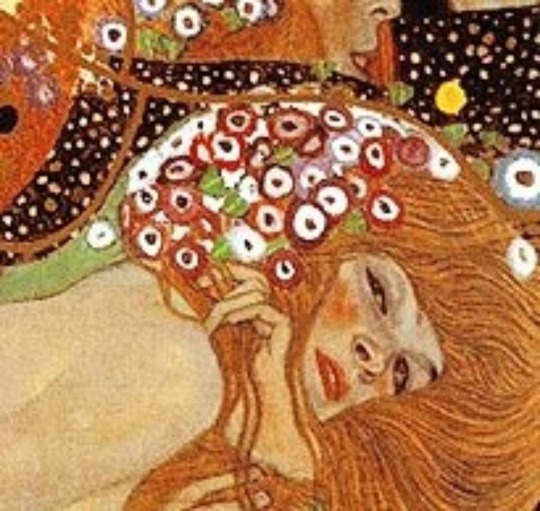
What could I love more than art? Women, goddesses and female hearts in art.
Ladies in Blue, fresco detail (Minoan art)
John William Waterhouse, A Mermaid
Fresco detail of Villa dei Misteri, Pompeii (Roman art)
Pablo Picasso, Portrait of Dora Maar
Louis Chalon, Circe
Remedios Varo, Mujer saliendo del psicoanalista
Marc Chagall, Lovers in Pink
Gustav Klimt, Water Serpents II
#marc chagall#john william waterhouse#pompeii#remedios varo#gustav klimt#louis chalon#pablo picasso#minoan art
77 notes
·
View notes
Text

This week's hyper fixation ; Minoan civilization.
The Minoans have been heavy on my mind lately. Maybe also because of the documentaries I've watched....
I love how colorful their frescos are and the fashions of the time 😌
Biggest issue; why is there so little left of them?? Why did they have to be wiped out like that... honestly wish I could go back in time to experience their culture and daily life.
77 notes
·
View notes
Photo

07: Swing
My Persephone in Minoan clothes swinging on a swing. A bit inspired by this clay model from Hagia Triada of a woman or a goddess sitting on a swing. 1500-1400 BCE.
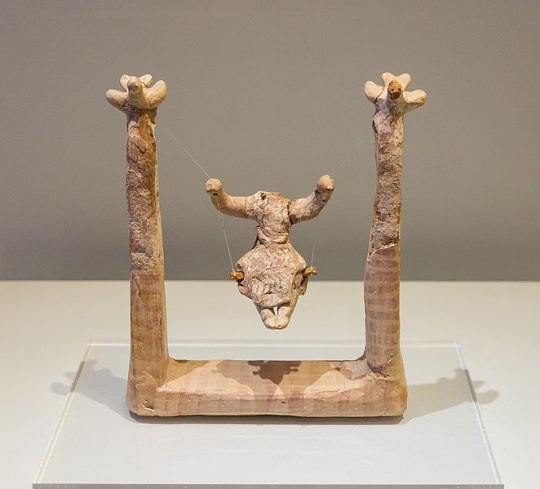
289 notes
·
View notes
Text
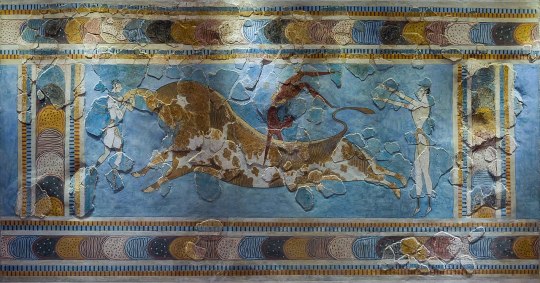
Minoan, Knossos Palace Upper Throne Room Gallery: The Bull Leapers, ca. 1450 BCE, fresco on stucco (Heraklion Archaeological Museum, Crete)
The Palace of Knossos, North entrance:
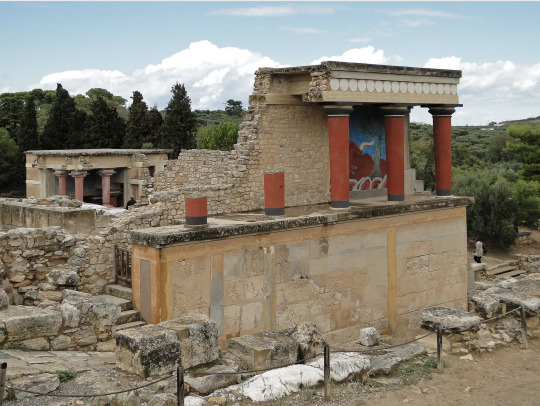
Upper Gallery of Throne Room:

Replica of The Bull Leapers in situ (placement on wall highly hypothetical):
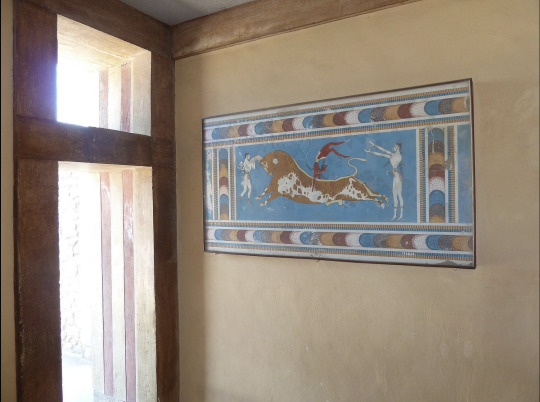
144 notes
·
View notes
Text
you got your known Minoans and your unknown Minoans (part four)
(reposted, with edits, from Twitter)
(part one, part two, part three on Tumblr)

Where were we? Oh yeah, bagging on Arthur Evans, right?
(You’re going to want to read Parts 1-3, linked above, if you haven’t already or this won’t make much sense.)
Did I mention in this that even though women appear frequently in other types of Minoan art, no composite ivory statuettes that are both definitely female and definitely genuine have been found? Interesting side note. Like the one thing we know about the Minoans is Snake Goddesses, right? Well, that and Bull Jumpers.
It’s hard to overstate the hold Minoan art still has on the Western imagination.

Image: A copy of a translation of the Odyssey, using the Blue Ladies fresco as cover art. Ironic, given that the culture that produced the Odyssey is probably the one that destroyed the Minoans.
Anyway, the problem is there are a ton of these composite ivory Minoan goddess statues floating around, none of them have reliable provenience, and they're what were used to authenticate each other. See the problem?
Some of them are proven forgeries. So a lot of what is "Minoan-looking" in our minds is forgeries, possible forgeries, and "restorations" done by turn-of-the-century artists.
And as we learn more about them, we find out that a lot of the assumptions were very much dictated by Victorian expectations. Those "corsets" or "jackets" Minoan women are depicted as wearing? Actually shifts with skirts tied around them.
There are a lot of problems with the Boston Goddess. She's too skinny, for one. And if, as some have suggested, her hips and butt are so flat because the ivory is significantly worn away, how are the details of her flounces still visible there? The Boston Goddess (or rather, the fragments of her not used in the restoration), the Seattle Boy-God, and the Ashmolean Boy-God have all been carbon tested. The results were intriguing-- 250ish years old for the Ashmolean figure, and 400-500 for the other two. That's deeply weird. Obviously, the ivory is far too new for them to be genuinely Minoan, but it's awfully old for a Victorian forgery.
But in any case, enough about the artifacts themselves. I want to talk about the conclusions Evans drew from them, which have been repeated as fact in a lot of books and textbooks and journals and magazines since.
The Great Goddess and Her Salesman-Priest
Classical goddesses go in and out of fashion. For most of the Renaissance, all the way to the 1800s, writers mentioned Venus and Diana most often, followed by Minerva/Athena and Juno/Hera. Diana was associated primarily with chastity.
In the Romantic era, Venus was still the most popular goddess (although she was now associated with natural surroundings), and Diana was associated with the moon and animals more than chastity. Proserpina/Persephone and Ceres/Demeter also gained prominence (earth/seasons).
So, the Romantics were very much enamored with the idea of Mother Earth/nature as female (go conquest that land in "virgin" America, yo). The concept wasn't new--lots of cultures personify the earth as female--but this was very much a 19th-century European imagining.
Basically a lot of Victorian dudes liked the idea of their porn involving pretty landscapes.
So, along comes a German dude named Friedrich Wilhelm Eduard Gerhard, because everything you say is credible if you're a white dude with four names, who's like "hey maybe all those Greek goddesses were actually ONE goddess, and she was Mother Earth, that tempestuous temptress."
And like as far as I can tell, that was it. That's the Tweet. He had An Idea about how ancient religion might have worked, and everyone nodded sagely and suddenly it was a theory. The Greeks actually believed in one goddess, with a bunch of different faces.
And then, some of those other dudes nodding along sagely to this theory that didn't arise organically from studying the actual writings and artifacts of the time, but from Mother Earth as a concept being trendy in the 1850s, were like, hey, so we know that the Anatolians and Mesopotamians influenced ancient Greek thought, so if the Greeks worshipped a single goddess, the Anatolians and Mesopotamians must have too!
And then they were like, hey, it was probably also true across Europe! Because there's this <checks notes> Swiss judge named JJ who thinks all of human society was once matriarchal and only later evolved into patriarchy so it seems logical that everyone worshipped a goddess.
For those following along at home, no, this is not how logic works, but these dudes were probably drinking a LOT of absinthe.
Goddess Worship Isn’t Love For Women
Now, one might point out, for example, that the ancient Athenians literally had a goddess as their patron deity and still managed to, arguably, utterly despise women more than anyone else in the world at that time, so clearly goddess worship doesn’t automatically equate to matriarchy, but anyway.
But Jessica! (I can hear you saying, o theoretical reader) You're such a shrieking feminist harpy that you put "howling maenad" in your Twitter bio. Why are you objecting to the idea of widespread ancient matriarchy and female-centered monotheism (or duotheism, since there was also a god)?
Well, here's the thing. It's certainly a cool idea. And it even makes a sort of pop-psychology sense. Back in the Stone Age, maybe men hadn't yet figured out that they were involved in the reproductive process and so deferred to women as life-givers.
But that sort of thinking can lead us to dismiss or ignore real history. Women have always led, women have always fought, women have always ruled, and that shouldn't be manwashed away. But that doesn't mean it was normative. And it matters--both for truthfulness and to fully appreciate what the women who managed to lead actually accomplished--if it wasn't normative. It can also make us miss that matriarchy--*real* matriarchy--isn't necessarily the mirror of patriarchy.
When I was in college, in one of my anthropology classes, we had a textbook that said that there was no such thing as matriarchy, except as a theoretical concept. There was matrilineality, and matrilocality, but not matriarchy.
Was it true? Well, here's the thing: if you define matriarchy as we define patriarchy, but just replace "men" with "women" in the description, arguably it is true that matriarchy doesn't exist. To the best of my knowledge, no one’s found evidence of societies where women treat men like men treat women in patriarchal societies.
But there are, and have been, societies where women own the property, societies in which elder women are the primary leaders/authorities, etc. But they don't attempt to exert control over men in the same way men do over women in a lot of patriarchal societies. So it becomes largely a semantic argument. If it isn't an exact analogue to patriarchy, is it matriarchy? Honestly, I've ceased caring all that much about the terminology, and am more interested in how leadership and authority function in those societies.
But anyway, the Romantics weren't feminists. Just because you like the idea of the feminine as emotional and intuitive and nature-y doesn't mean you give a shit about actual women. And as the Victorian Angel In The House would show us, every pedestal has a cage atop it.
The Romantics might profess to revere Mother Nature, but at the end of the day, they revered her as an object: there to be conquered if they wanted to feel manly, there to challenge them if they wanted to feel manly in a different way, there to soothe and inspire them as Muse, and even there to kill them if they were into the idea of la petite mort being la grand mort.

Image: Just a dude really into being penetrated... with arrows.
And Bachofen, our pal JJ the Swiss judge who also had Theories about anthropology, considered humanity's "Demetrian" matriarchal stage just a necessary transitional period on its way to "Apolline" patriarchy, the pinnacle of human evolution.
They dug up a lot of Venus of Willendorf-like figurines (lots of male-looking and animal ones too, but those didn't fit the theory and got ignored) and decided that they represented a single prehistoric Mother Goddess, source of fertility.
I mean here's the thing: when archaeologists find something and they don't know what it is or what it's used for, a popular default category is "ritual object." If you then start forming theories about how religion worked based on your collection of ritual objects, well, you can imagine how that goes.
So this is the milieu into which Arthur Evans was to release his Minoan discoveries. He writes a lot about the "Great Minoan Goddess" and "the matriarchal stage of society, to which the Minoan religious system owes its origin."
I Regret to Introduce You To Jane Harrison...
So along comes Jane Harrison, who is all into JJ's theory about ancient matriarchy as the fullest collection of "ancient facts"--poof! the theory has become fact--and was also very into the idea that all goddesses are actually a single Great Goddess.
If you don't know anything about Jane Harrison, you might be thinking, "oh, good! at last, a woman weighing in on ancient matriarchy. Perhaps we'll get a take that isn't so... patriarchal.”
Allow me to introduce you to Jane Harrison:
"Matriarchy gave women a false sense of magical prestige. With patriarchy came inevitably the facing of a real fact, the fact of the greater natural weakness of women. Man is the stronger, and when he outgrew his belief in the magical potency of woman, proceeded by a pardonable practical logic to despise and enslave her."
...And All These Other Assholes
Another member of these circles was Sir James George Frazer (only three names there, but also has a "Sir" so probably as credible as the four-name dude). Remember him? The Golden Bough? Yeah.
He looooved the idea of a single Great Mother Goddess and attempted to collect and catalogue world myth and folktales and wanted to trace her and her ever-dying younger consort as a universal or near-universal archetype in human consciousness.
You want Joseph Campbells? This is how you get Joseph Campbells. But Joseph Campbell is a rant for another time.
Carl Jung and Marija Gimbutas, incidentally, thought along similar lines and considered it a universal archetype present in all human psyches, and all cultures.
No writing or art about it from a particular culture? No evidence that it’s actually a thing? *hand wave* Whatever.
Part of what was animating all this thought was confidence that human culture was evolutionary--that there was a relatively smooth line of human progress from a primitive past to an enlightened present to a utopian future.
I mean, the Bronze Age collapse might beg to differ. But what do I know? I'm not a white dude with four names and or a "Sir".
Incidentally, this Victorian confidence that human civilization is smoothly evolutionary appears to be literally killing us right now but let's pretend this is all fun archaeology stuff to mute the silent internal screaming.
Oh Wait, I Forgot To Tell You About The Cat
Anyway. All of these assumptions very much influenced how Evans interpreted what he found, and presented it to the public. Female snake handlers, for example, are actually pretty rare in Minoan art (maybe even all forged), but you wouldn't know that from textbooks about it.
It affected how he arranged the things he found when attempting to recreate altar assemblages.
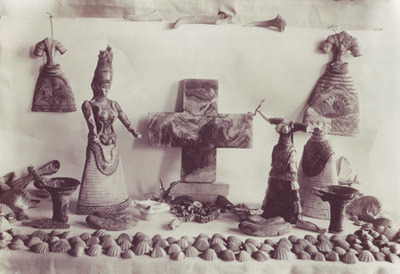
That cross in the assemblage above? They found that and decided that it MUST have religious significance and be the centerpiece of an altar... ...because Christianity, basically.
You know that famous Snake Goddess figurine?
The faience one that isn't a suspected complete fake? You've probably seen her. You can buy earrings of her on Etsy.

That cat on her head?
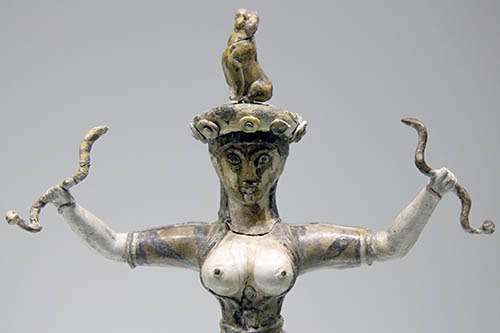
Yeah, it's a random cat that they found elsewhere and decided to stick on her head.
...because the Anatolian and Mesopotamian goddesses they liked to use as proof of a universal singular Great Mother Goddess were often pictured with lions.
So, you know: cat-hat.
About Those Snakes...
So anyway, snake-handling female figures were actually a relatively rare find in Minoan art, but Evans decided she was their central deity, a manifestation of the Great Mother Goddess whose primary attribute was fertility.
But here's the thing: we don't have any writings we can read from the Minoans. All we have is visuals (mostly "restored" by Victorian artists), and we don't *know* what any of their symbolism meant to them. And even a lot of the visuals aren't helpful.
We know that depicting women with bared breasts (not topless, with a garment framing them, which seems very deliberate) was a thing. We don't know what that means. We don't know if this was reflective of *actual clothes that women wore* or whether it's symbolic (like Artemis wearing a crescent moon in her hair). We don't know what breasts meant, in their visual language.
Minoan art doesn't depict children very often, and doesn't depict nursing mothers at all (unlike Egyptian or mainland Greek art). So do breasts represent fertility in their visual vocabulary? No idea.
Are bared breasts considered erotic? Again, no idea. That assumption was strongly tied to the snakes, which are tied to Christian associations of snakes with sexuality--specifically sexual sin. If the bared-breasts women were actually even originally depicted with snakes.
Ultimately, we don't even know if the statue of a snake-handling woman represents a goddess, a priestess, or a woman representing or symbolizing something else entirely. Frankly, we don't even know what her face actually looked like.
Despite various authors rhapsodizing about the "sternness of her expression" and whatever else, the entire face of this famous statue, and her snakes, were fashioned by Halvor Bagge, a restorer/artist. She might have been holding sheaves of grain, for instance. She might have been smiling gently. She might have looked afraid. We don't know.
We know very little.
Who Better To Say What We Want than Those Who Can’t Speak?
Because the Minoans didn't leave behind any writing we can read, and most of the art we have from them had to be heavily restored by Victorian artists, they provided a perfect blank slate for Victorian men desperate to prove European superiority to project onto.
Now. Archaeologists *aren't* just people who dig up old stuff. Interpreting the past is something we have to do if we want to try to understand it. And there's nothing wrong with putting forth theories. But it becomes a problem when it's not made clear that these are theories, when theories are built upon theories upon theories upon theories, with no clear substantiation for any of it. Theory slides into "fact" very easily.
And it can very easily become circular. Evans used theories about other cultures worshipping a single Great Goddess to guide what he looked for on Crete and how to present what he found, which has looped around to Crete being the center of Great Goddess worship and being used to substantiate the idea of singular Great Goddess worship in some of the same cultures whose practices were used to suggest that Crete might be like they were. Much like ivory statuettes with no provenience were used to substantiate others.
And all of that is then used as evidence of How Human Culture Works. So suddenly The Center Of Ancient Mediterranean Worship is safely in Europe.
When, as far as what can actually be verified, what doesn't come out of the airy, tempestuous realms of Romantic theory, is almost nothing.
We still don't know the Minoans.
Fin.
#archaeology#arthur evans#crete#white supremacist archaeology#snake goddess#art forgery#minoan art#matriarchy#goddess worship#the great goddess#romanticism#minoan#minoans
97 notes
·
View notes
Text

Terracotta vase in the form of a bull's head, Minoan, circa 1450-1400 BC
from The Metropolitan Museum of Art
525 notes
·
View notes
Text
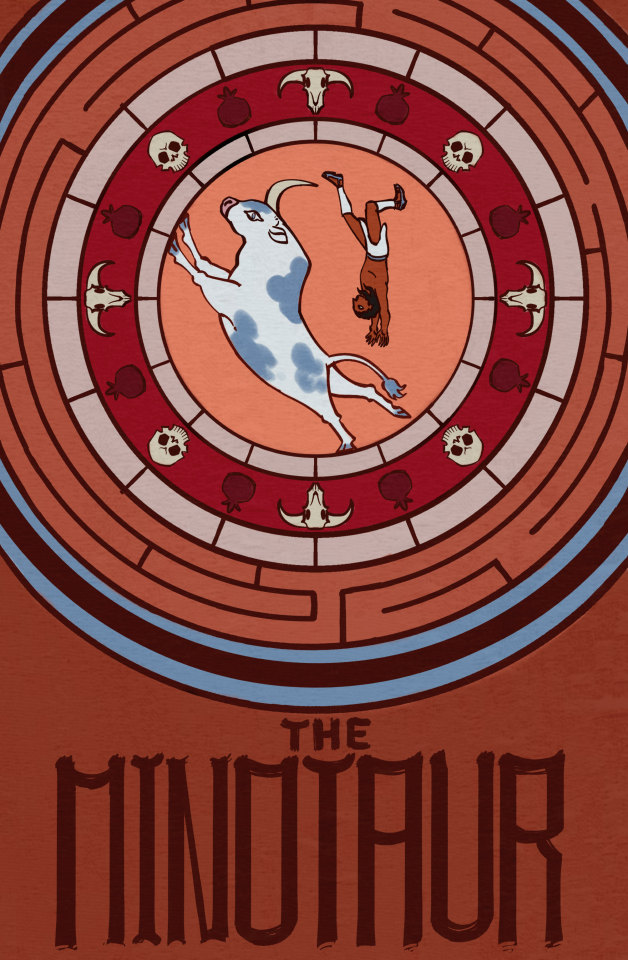
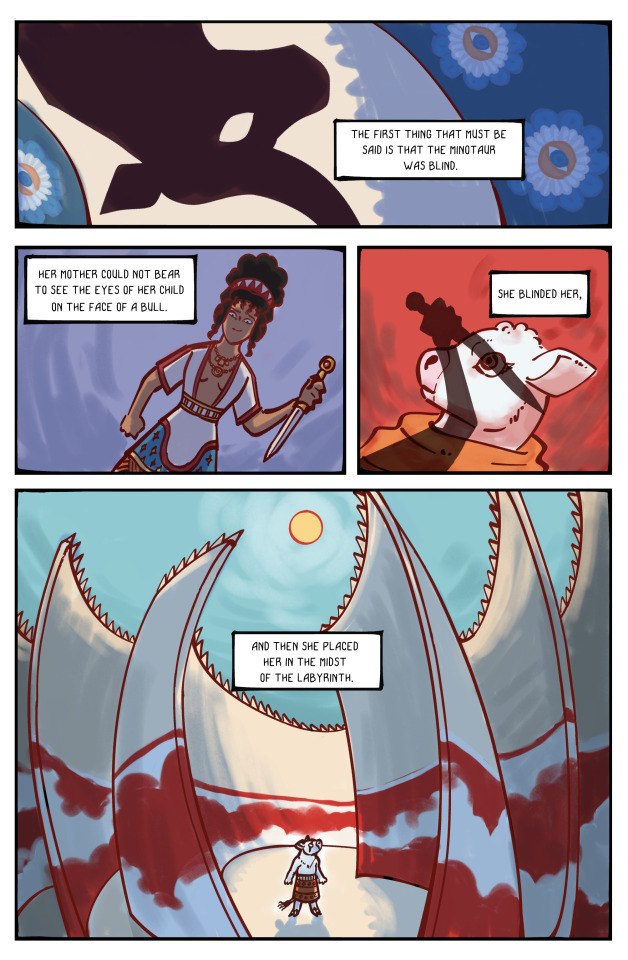
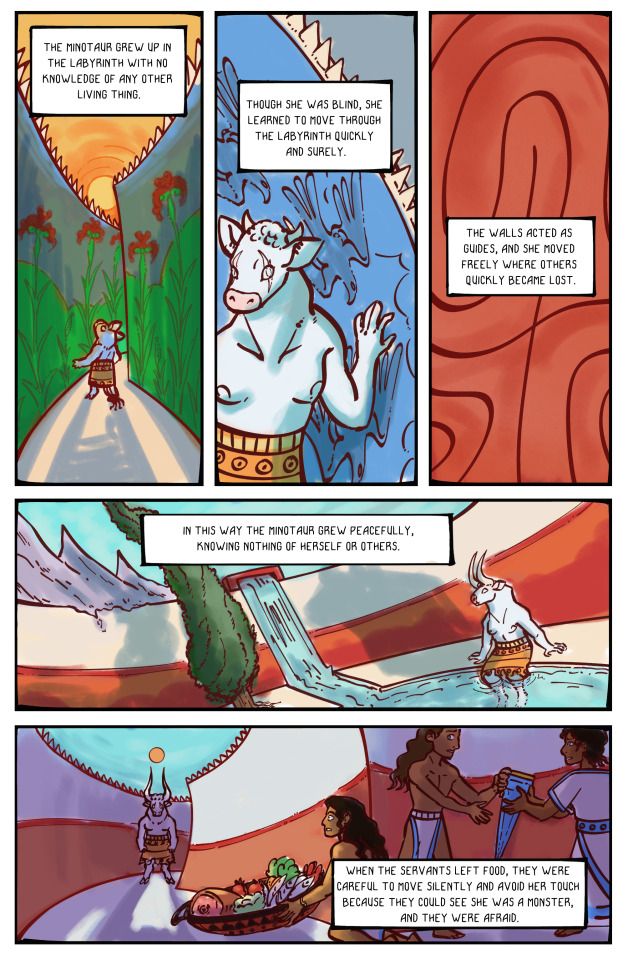
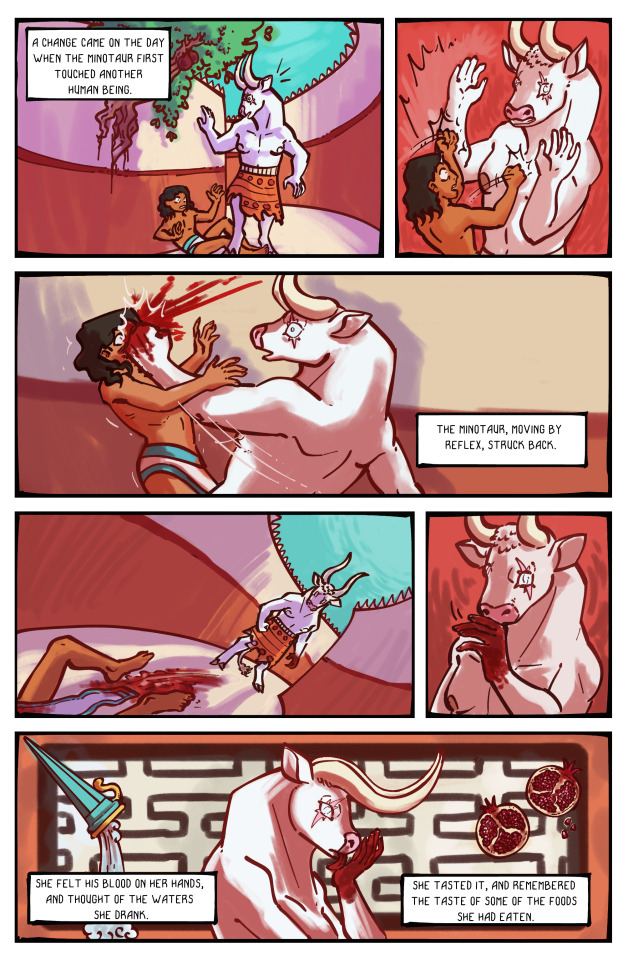
Hey there! This is a new comic I made, THE MINOTAUR! It's a 12 page comic version of a short story by Andrew Shalit that I did for class; an adaptation of the Myth of the Minotaur (with a few twists!) from the point of view of the creature. The art style is inspired by Minoan art and frescoes, and the PDF also has 4 extra pages of sketches.
You can download the PDF (completely for FREE!) here!
The original story can be read here!
#my art#comics#mythology#minotaur#minoan art#greek mythology#history#minoan culture#i spent three months of my life makingthis and even though that i Love It i cant really look at it anymore. anyways hope yall like it! <3
17 notes
·
View notes
Text

Arthur Evans' reconstruction of the Dolphin Frescos, Knossos Minoan archaeological site, Crete
#minoan#minoan art#minoan crete#minoan civilization#artistic#art#greek art#knossos#greece#creteisland
400 notes
·
View notes
Text
Minoan cutie WIP
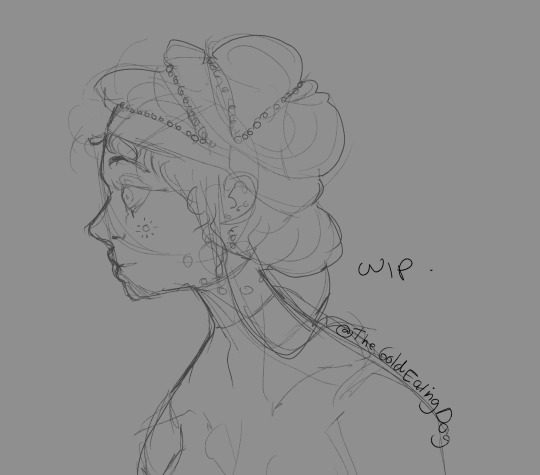
#ancient history#ancient greece#minoan#minoan civilization#historical#historical art#history#digital art#knossos#fresco#ancient art#antiquities#minoan art#nature#wildlife#beautiful dolphin#aesthetic#beauty#animals in art#art history#aesthetictumblr#ancient world#tumblraesthetic#tumblrpic#tumblr art#tumblrstyle#artists on tumblr#current wip#art wip#work in progress
2 notes
·
View notes